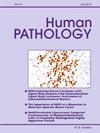同种异体造血干细胞移植患者嗜酸性粒细胞丰富的食管炎模式:多中心经验
IF 2.6
2区 医学
Q2 PATHOLOGY
引用次数: 0
摘要
嗜酸性粒细胞丰富的食管炎是一种炎症模式,其特征是上皮内嗜酸性粒细胞增加,与包括嗜酸性粒细胞性食管炎(EoE)在内的多种疾病有关。在造血干细胞移植(HSCT)患者中,嗜酸性粒细胞丰富的食管炎是非常罕见的,并且与移植获得性过敏(TAA)相关。这项多中心研究的目的是描述HSCT患者食管活检与嗜酸性粒细胞丰富的食管炎模式的临床和病理特征。10例确诊为中位年龄45岁(范围:10 - 76岁),包括7例男性。从HSCT到活检的中位时间为6个月(范围:0-3)。3例患者在移植后21天内出现,其中2例出现凋亡小体。嗜酸性粒细胞/HPF的中位数为25(范围:16-102),嗜酸性粒细胞脱粒6例,嗜酸性脓肿3例,凋亡小体5例,角化异常细胞3例。在5例HSCT 21天后出现的患者中,2例患者(凋亡小体和角化异常细胞)和1例患者(仅凋亡小体)出现了GVHD的特征,均为胃肠道外GVHD。2例患者对左氧氟沙星、苯海拉明等药物发生TAA, 1例患者发生输血过敏反应。只有1例患者符合EoE的诊断标准。基于这些有限的病例,HSCT患者表现为嗜酸性粒细胞丰富的食管炎模式与调节方案诱导的损伤和GVHD相关,并见于TAA患者。本文章由计算机程序翻译,如有差异,请以英文原文为准。
Eosinophil-rich esophagitis pattern in patients with allogenic hematopoietic stem cell transplantation: a multicenter experience
Eosinophil-rich esophagitis is a pattern of inflammation characterized by increased intraepithelial eosinophils which is associated with a wide range of disorders including eosinophilic esophagitis (EoE). In hematopoietic stem cell transplant (HSCT) patients, eosinophil-rich esophagitis is exceedingly rare and associated in one prior case to transplant-acquired allergy (TAA). The goal of this multicenter study was to characterize the clinical and pathologic features of esophageal biopsies with an eosinophil-rich esophagitis pattern in HSCT patients. 10 cases were identified presenting with a median age of 45 years (range: 10–76), including 7 men. The median time lapsed from HSCT to biopsy was 6 months (range: 0–3). 3 patients presented within 21 days of HSCT, 2 of which showed apoptotic bodies. The median number of eosinophils/HPF was 25 (range: 16–102), 6 cases showed eosinophilic degranulation, 3 cases had eosinophilic abscesses, 5 cases showed apoptotic bodies, and 3 cases had dyskeratotic cells. Of the 5 patients presenting after 21 days of HSCT, features of GVHD were seen in 2 patients (apoptotic bodies and dyskeratotic cells) and 1 patient (apoptotic bodies only), with all of them having extra-gastrointestinal GVHD. 2 patients developed TAA to medications, levofloxacin and diphenhydramine, and 1 patient had an allergic transfusion reaction. Only 1 patient met diagnostic criteria for EoE. Based on these limited cases, HSCT patients presenting with an eosinophilic-rich esophagitis pattern were associated with conditioning regimen-induced injury and GVHD and seen in patients with TAA.
求助全文
通过发布文献求助,成功后即可免费获取论文全文。
去求助
来源期刊

Human pathology
医学-病理学
CiteScore
5.30
自引率
6.10%
发文量
206
审稿时长
21 days
期刊介绍:
Human Pathology is designed to bring information of clinicopathologic significance to human disease to the laboratory and clinical physician. It presents information drawn from morphologic and clinical laboratory studies with direct relevance to the understanding of human diseases. Papers published concern morphologic and clinicopathologic observations, reviews of diseases, analyses of problems in pathology, significant collections of case material and advances in concepts or techniques of value in the analysis and diagnosis of disease. Theoretical and experimental pathology and molecular biology pertinent to human disease are included. This critical journal is well illustrated with exceptional reproductions of photomicrographs and microscopic anatomy.
 求助内容:
求助内容: 应助结果提醒方式:
应助结果提醒方式:


